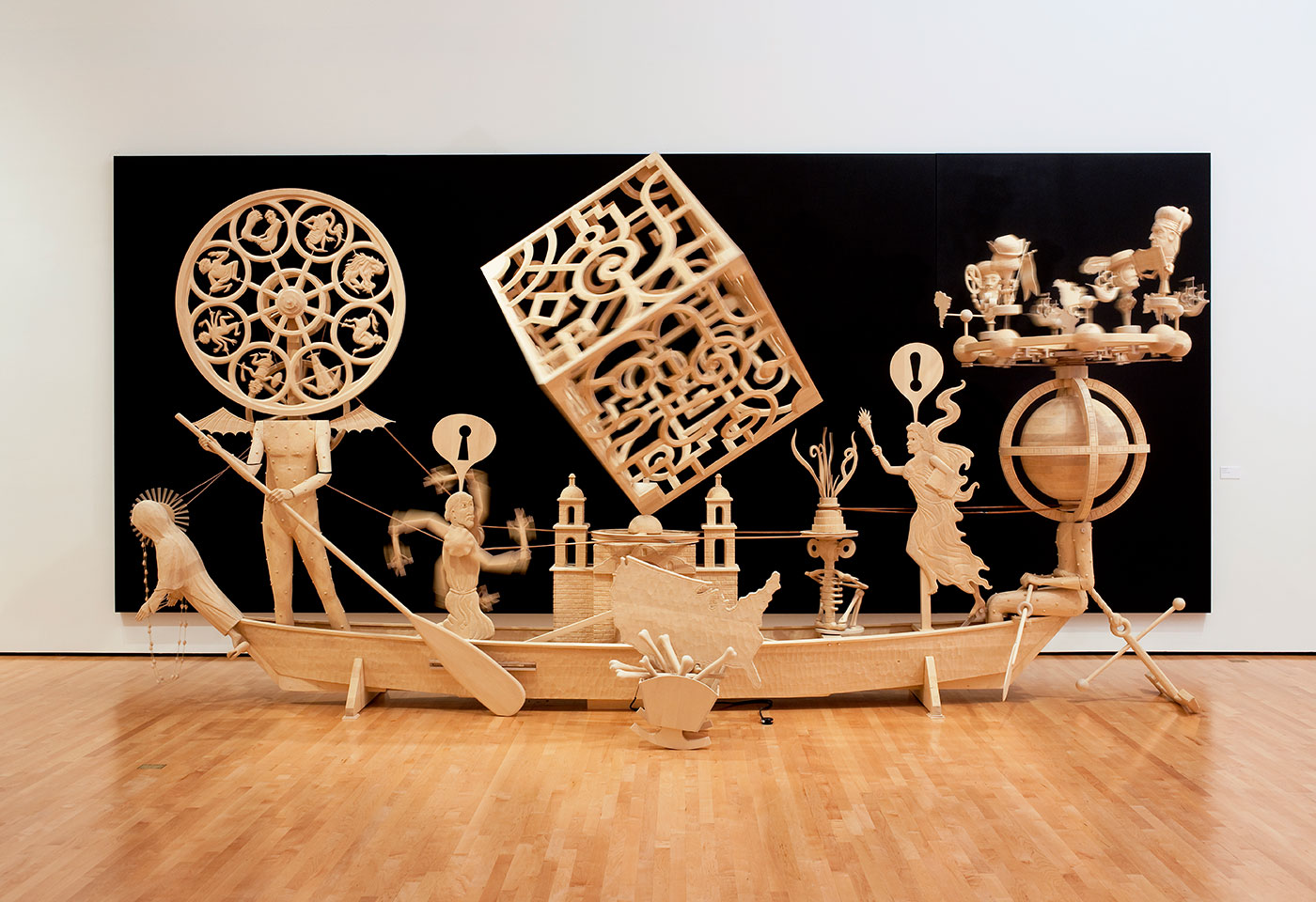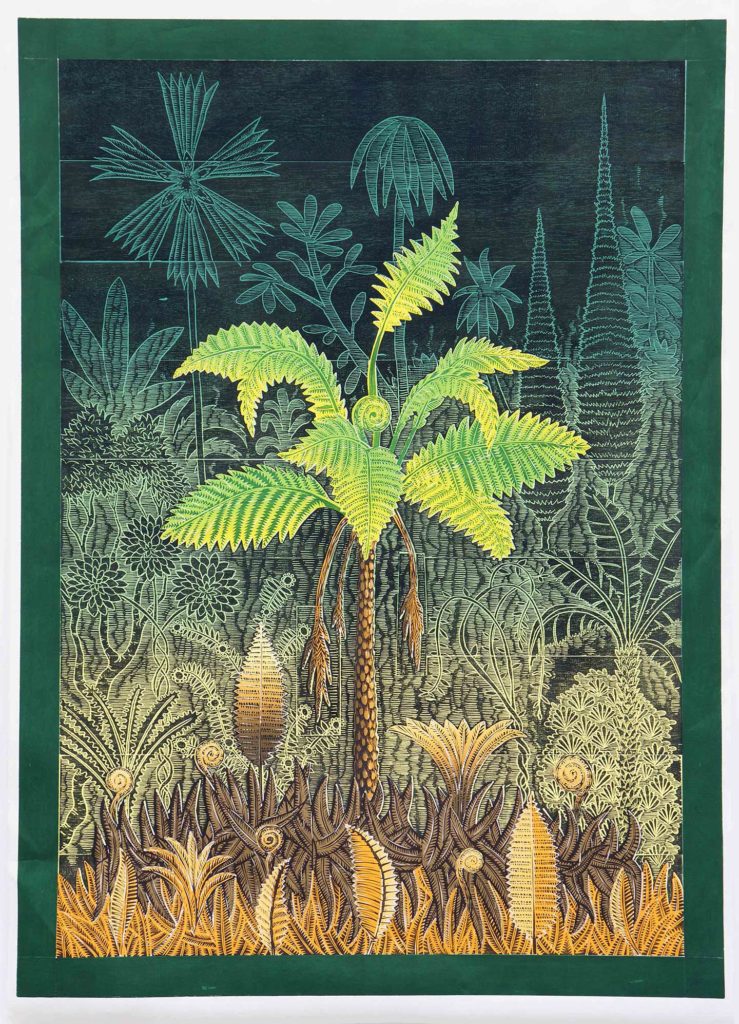Text by Le‘a Gleason
Images courtesy of the artists & Honolulu Museum of Art
Deborah Butterfield arrived in the world in 1949, on the 75th anniversary of the Kentucky Derby. Fittingly, she developed a fascination with horses at an early age, and by the mid 1970s, she was sculpturing the creatures. For Butterfield, these artistic creations are self-portraits. To the world, these unique horse forms are her hallmark.
Butterfield creates her sculptures from fallen branches that she has carefully collected in nature, after which she assembles to represent another part of nature: the figure of a horse. “I gather wood from different locations of rivers and mountains,” she says. “I’m very moved by the history that’s in the wood … and this narrative that’s entombed in it.”

The shapes of the found wood guide the equine forms Butterfield creates. They stack and overlap into the shape of a neck, a hindquarter, a tail, a life-size horse, but through the gaps, you can glimpse the interior of the creature, and gaze all the way through it. The form is then cast in bronze. Her process creates a natural patina on the metal, making it once again appear, amazingly, as wood. “I guess I’m trying, within my own intentional composition, to mimic those things we apprehend in nature,” she explains.
Kelly Sueda, Park Lane’s art curator, chose one of Butterfield’s sculptures for the development’s collection of 500 hand-selected, original art works from around the world. Reflecting on Butterfield’s sculptures, Sueda says, “A horse, being an iconic figure, can say so much. Is it calm, ready to charge, ready to race? When people see them for the first time, they think it’s wood, and then they feel or touch it and find out it’s bronze. There’s now this visual and emotional interest, in addition to the power or serenity that looking at the work evokes.”
Butterfield cultivated her talents at the University of California, Davis, from which she earned a bachelor’s and master’s of fine arts degree. This school is also where the sculptor found her partner, in love and art—John Buck. From the beginning, she remembers finding it easy to relate to Buck. They would spend long hours in the studio, watching and learning from resident artists, and found an intimate connection through their work.
“I think for both of us, it’s the same life. We don’t know anything else,” Butterfield says. “You have this work ethic, and this is the most important thing there is. It makes us not good at social stuff, vacationing, business, and connections, because we just want to be in our studios,” she adds with a laugh.
During his long studio hours, Buck creates carved wood and bronze sculptures, woodblock prints, and complex mechanical-kinetic sculptures. At Park Lane, Buck’s piece depicts the figure of a woman with a head like a square gate. “As a form, it’s really incredible,” Sueda says. “At night, it’s silhouetted with this beautiful limestone wall behind it. During the day, when the sun hits it, it casts this wonderful shadow on the wall.”
For the artist, creating is about more than just aesthetics. “I experiment with the conventions of the traditional art form, which is the ‘figure,’ and from that point, I go to political issues, social issues,” says Buck. “They’re not hidden behind the mask of a face, but they’re the face of an idea.”

Butterfield sees similarities in her creations and those of her husband. “The horse shape is my canvas, and then the composition is the internalization of emotions in the shape of this horse,” she explains. “With John’s work, there’s a figure, and instead of a head, there’s an abstract construction from the shoulders up, which for me, I read as a diagram of his thoughts.”
In 1986, an opportunity to create works for a show for the Honolulu Advertiser brought the pair from Montana to Hōlualoa on Hawai‘i Island’s west side, where Thurston Twigg-Smith, a longtime art collector and art supporter, provided them a home and studio space in which to work. They loved the climate, the concentration of artists living in the area, and the slower pace of island living, so in 1987, they built a home there.
Today, the couple resides part-time in Montana and roughly three months of the year in Hōlualoa. Butterfield also has a foundry in Walla Walla, Washington, where she does her large-scale metal work.
At Park Lane, Butterfield’s majestic grazing horse is at home in the entryway to the lobby. Nearby, along Park Lane’s strolling path, stands Buck’s sculpture Down Stares. Those who pass by often stop to admire the patina on Butterfield’s horse, and to touch it, only to find that it isn’t wood. Others pause, dazzled by the sunlit bronze of Buck’s piece, or its unexpected composition.
“I think great art is one that evokes emotion from everybody,” Sueda says. “You can’t just walk by it.”









